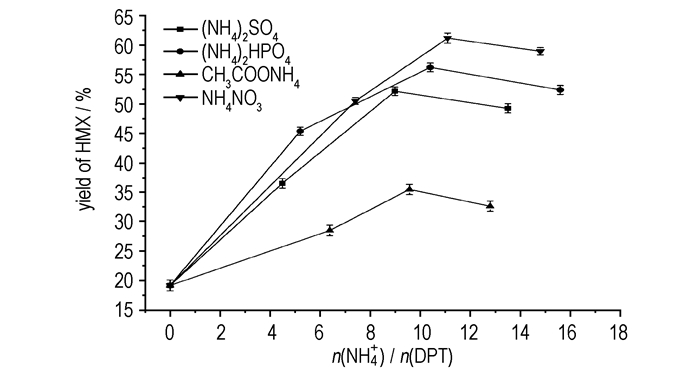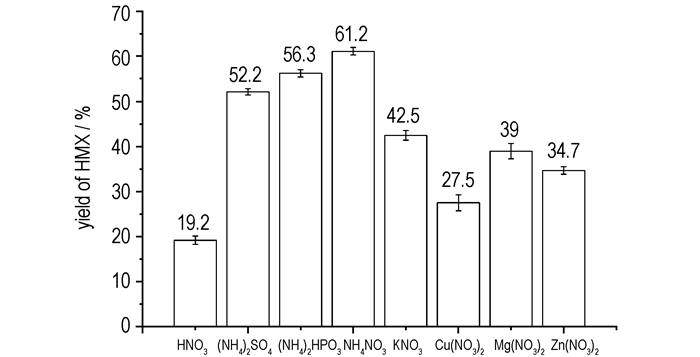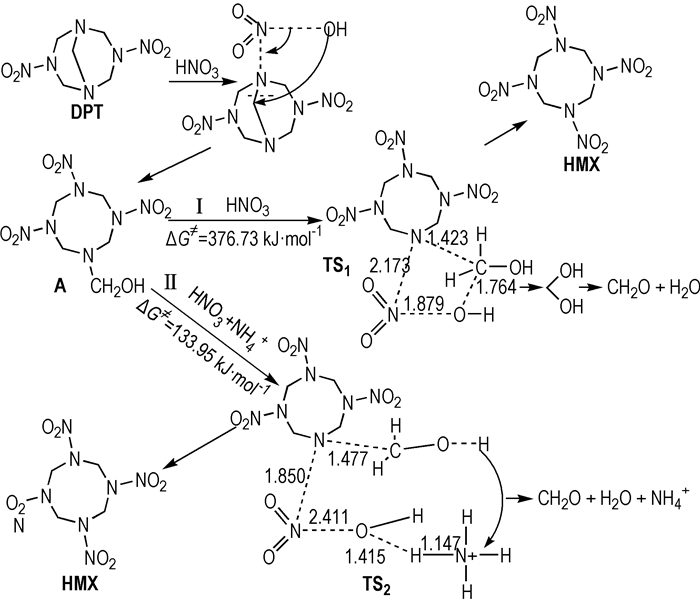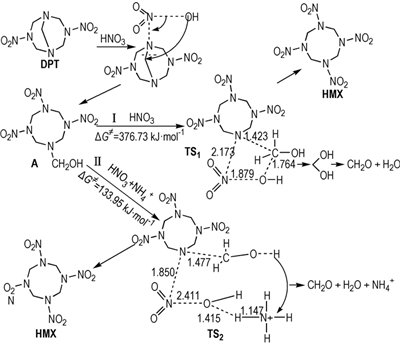2. Department of Applied Chemistry, School of Chemical Engineering & Environment, Beijing Institute of Technology, Beijing 100081, China
2. 北京理工大学化工与环境学院应用化学系, 北京 100081
Octahydro-1, 3, 5, 7-tetranitro-1, 3, 5, 7-tetrazocine (HMX) is one of the most popular explosive compounds with high density, high energy and excellent thermal stability. Reported manufacturing process for HMX involves the nitrolysis of hexamine in the ternary systems including nitric acid, ammonium nitrate and acetic anhydride, among which the Bachmann process is the most classic method [1]. However the expensive acetic anhydride leads to a relatively high cost of HMX in Bachmann process, and then its application was greatly limited in high energetic explosive. Owing to the above reason, a new preparation process of HMX through the key precursor, 3, 7-dinitro-1, 3, 5, 7-tetraazabicyclo[3, 3, 1]nonane(DPT)[2-3], has attracted great attention due to the low cost, high security and convenient performance. The nitrolysis of DPT is the committed step in DPT process. Different nitrolysis methods for DPThave been explored intensively, among which the HNO3-NH4NO3 method is most promising [4-8]. Compared to the Bachmann process, the cost of HMX is significantly reduced by employing the HNO3-NH4NO3 method.
NH4NO3 as additive plays a key role on the nitrolysis of DPT [9-10]. The yield of HMX in HNO3-NH4NO3 system is 40% higher than that in pure nitric acid in general [5-6]. However, the action mechanism of NH4NO3 is poorly known in the nitrolysis of DPT. Currently, the nitrolysis process of DPT in HNO3-NH4 NO3or HNO3 is speculated as shown in Scheme 1 [7, 9]. HMX and 1, 9-dinitroxy-2, 4, 6, 8-tetranitro-2, 4, 6, 8-tetrazacyclononane (C) are two kinds of main products. When NH4NO3 was absent in HNO3 solution, C got superior position. But by adding NH4NO3 into HNO3 solution, HMX was prepared instead of C. McKay et al[9] considered that NH4NO3 in nitrolysis system served to hinder esterification and promote demethylolation on 1-hydroxymethy-l-3, 5, 7-trinitro-1, 3, 5, 7-etrazacyclooctane (A). Chen et al [4] found that nitrate can also improve the yield of HMX and hence inferred the common ion effect of NO3- was the main factor. And yet, the effect of NH4+ has not been studied independently by now. Therefore the conjecture of former scholars was still far insufficient.

|
Scheme1 The nitrolysis of DPT in nitric acid-ammonium nitrate or pure nitric acid |
Based on the two involved mechanisms (Scheme 1) of DPT nitrolysis via HNO3-NH4NO3 or HNO3 [7, 9], the role of NH4NO3 was researched further by experiment and theoretical calculation in this study. Firstly, the role of NH4+ and NO3- in DPT nitrolysis was investigated and compared in nitric acid-ammonium salt systems and nitric acid-nitrate systems respectively. Then on the basis of experiment research, two possible DPT nitrolysis mechanisms in HNO3/NH4+ and HNO3 were proposed. And the catalytic effect of NH4+ was investigated theoretically through the density functional theory[11-12].
2 Experiment section 2.1 Reagents and InstrumentsDPT was prepared by Xi′an Modern Chemistry Research Institute[3], with the purity over 99%. HNO3 was purified before use. Others are analytical reagents and commercially available without further purification.
Melting points were determined microscopically on an X-5 precision micro melting point apparatus. 1H NMR spectra were recorded on a Bruke AV-400 spectrometer, FT-IR (KBr) spectra were recorded on a PerkinElmer FT-IR spectrometer, and mass spectra were collected on a HP5989B mass spectrometer. The purity of HMX was checked on Shimadzu LC-2010 HPLC.
2.2 The nitrolysis of DPT in nitric acid-ammonium salt or nitric acid-nitrateThe preparation process of HMX as used in this research was a modification on the original HNO3-NH4NO3 method for the nitrolysis of DPT [5]. In a three necked round bottomed flask equipped with magnetic stirring assembly, 10.0 mL of HNO3and a certain amount of ammonium salt or nitrate were mixed. The temperature of the nitrolysis system was maintained at (5.0±1.0) ℃. 2.0 g of DPT was added slowly into flask, and the system temperature would rise to 7-8 ℃. After DPT addition, the reaction was continued for another 30 min and then the temperature was increased to and kept at 25 ℃ for 40 min. Then, the reaction mixture was poured into ice water. The solution was neutralized by ammonia and pyrolyzed at 90 ℃.HMX was washed several times with water and then dried.
The sample was characterized. Melting point: 279-281 ℃; FT-IR (ν/cm-1): 1559.28, 1461.88, 1394.96, 1201.94, 1143.63, 1086.52, 945.72, 760.31 and 599.70; 1H NMR (DMSO-d6), δ=6.02 (8H, singlet); MS:[M+Cl]-~331, [M+HCOO]-~341, [M+NO3]-~358. Purity: 98.6%.
2.3 Calculation methodsThe optimized geometries and correlative energies of the reactants(R), transition states (TS), and products (P) were generally calculated at B3LYP/6-31G (d, p) level. The exchange-correlation potential in the B3LYP DFT method was constructed from Becke's three parameter formula (B3) foe exchange [13] along with the Lee-Yang-Parr parameterization for correlation (LYP) [14]. 6-31G (d, p) was a split-valence double-zeta plus polarization basis set [15]. The structures and imaginary frequencies of transition states were confirmed by the calculation of both vibration analysis and the intrinsic reaction coordinate (IRC) [16-17] at the same level. All compounds had true minima on their potential energy surface without imaginary frequency and the transition state had only one imaginary frequency. All calculations were performed on a Lenovo T350 server with two Intel Xeron 5620 processors using the Gaussian 09 software package [18] in our laboratory.
3 Results and discussions 3.1 The nitrolysis of DPT via nitric acid-ammonium saltThe presence of NH4NO3 served to hinder esterification and promote demethylolation on A (Scheme 1), a key intermediate in the nitrolysis of DPT[9], and the role of NO3- in improving the yield of HMX had been studied[4]. However, the role of NH4+ had not been researched. In this section, various ammonium salts were used to investigate the role of NH4+ . The nitrolysis of DPT was performed in nitric acid-ammonium salt including [(NH4)2HPO4, (NH4)2SO4 and CH3COONH4] systems. The experiment was optimized furtherly by varying the concentration of NH4+ , and repeated three times in one concentration. The results, compared to the yield via HNO3-NH4NO3 or pure nitric acid, were shown in Fig. 1.

|
Fig.1 The yield of HMX varying with n (NH4+ )/n (DPT) |
As shown in Fig. 1, the yield of HMX in pure nitric acid is 19.2%. By addition of the ammonium salt, the yield of HMX would be improved greatly. The highest yield of each lab group is 56.3% [(NH4)2HPO4], 52.2% [(NH4)2SO4] and 35.5% (CH3COONH4), respectively. Result shows the effect of (NH4)2HPO4 and (NH4)2SO4 are very significant, because their highest yields are close to that in HNO3-NH4NO3 (61.2%). And if the hygroscopicity of CH3COONH4 decreases, the yield may much likely to be improved in HNO3-CH3COONH4. To exclude from interference of HPO42- and SO42-, nitrolysis of DPT was done in HNO3-K2 HPO4 and HNO3-K2SO4 systems separately. And K+ was considered to be no effect on improving the yield of HMX[4, 9]. As expected, the yields of HMX are 28.3%(K2 HPO4) and 25.6%(K2SO4), which are all much lower than those in HNO3-(NH4)2HPO4 and HNO3-(NH4)2SO4 systems. So it's believed that NH4+ of the added ammonium salt greatly improves the yield of HMX. Moreover, Fig. 1 shows the yields of HMX in the four nitric acid-ammonium salt systems increase at the beginning and then decline with the increase of the molar ration of NH4+ and DPT. And the values of n (NH4+ )/n (DPT) at the highest yield of HMX are approximately the same as about 10 (9.6, 9.0, 10.4 and 11.1, respectively). Result is meaningful and further studies should be carried out to explore the underlying reasons.
3.2 Comparison of the role of NH4+ and NO3- in DPT nitrolysisChen Li et al [4] had proven that the common ion effect of NO3- played a role in improving the yield of HMX. And at the previous section, the result also indicated that NH4+ could improve the yield. So it is absolutely necessary to compare the affection of NH4+ and NO3-, and this is significative for further studying the effect mechanism of NH4NO3. In this section, the nitrolysis experiment of DPT was performed in various nitric acid-nitrate systems [including KNO3, Cu(NO3)2, Mg(NO3)2 and Zn(NO3)2]. And the highest yield of each lab group was achieved by optimizing the preparation process. The comparison result between nitric acid-ammonium salt systems and nitric acid-nitrate systems was shown in Fig. 2.

|
Fig.2 Comparison of the role of NH4+ and NO3- in nitrolysis of DPT |
As shown in Fig. 2, the highest yield of HMX in various nitric acid-nitrate systems was 42.5% (KNO3), 27.5% [Cu(NO3)2], 39.0% [Mg(NO3)2] and 34.7% [Zn(NO3)2], respectively, and little higher than that (19.2%) in pure nitric. But comparing to the highest yield (56.3% and 52.2%) in HNO3-K2HPO4 and HNO3-K2SO4, there are obvious disparities. So the comparison shows the affection of NH4+ in improving the yield of HMX is far higher than NO3-. According to the results above, it can be believed that the role of NH4+ in NH4NO3 was absolutely dominant.
3.3 Mechanism of NH4+ in the nitrolysis of DPTThe dominant role of NH4+ in promoting the nitrolysis of DPT had been proved. Si et al[19] studied theoretically the mechanism of NH4+ catalysis in the nitrolysis of amides and also believed it could promote nitrolysis. Because of the inherent limits of quantum chemistry in the studies of the theoretical possibility of a reaction and its mechanism, recently, the density functional theory (DFT) based on the first principle had been increasingly used in the studies of molecular geometry, total energy, vibrational frequency and organic reaction mechanism [11-12]. So the mechanism of NH4+in hindering esterification and promoting demethylolation on 1-hydroxymethy-l-3, 5, 7-trinitro-1, 3, 5, 7-etrazacyclo-octane (A) would be verified further by DFT in this section.
According to the proposed mechanisms, the transition state without NH4+ (TS1) was designed to N—C—O—N tetraatomic ring geometry and the transition state with NH4+ (TS2) was designed to N—C—O—H—N—O octotomic ring geometry (Scheme 2). The key bond lengths of transition states, activation energy barriers and potential energy profiles of reverse channels were all shown in Scheme 2. And the results were originally from IRC at B3LYP/6-31G** level.

|
Scheme2 The possible mechanisms for DPT nitrolysis in the absence or presence of NH4+(The A, TS1 and TS2 represent intermediate and transition states respectively. Ⅰ and Ⅱ represent the channels.) |
As shown in Scheme 2, firstly, the amino nitrogen of —(CH2)3N group in DPT is attacked by nitric acid molecule and CH2—N of the bridge methylene is broken to produce —(CH2)2N—NO2 and CH2—OH. Then, 1-hydroxymethy-l-3, 5, 7-trinitro-1, 3, 5, 7-etrazacyclooctane (A) is nitrated in two kind nitrolysis systems of HNO3 (channel Ⅰ) and HNO3/NH4+ (channel Ⅱ). In channel Ⅰ, the nitrogen atoms of —N—CH2OH is attacked directly by nitric acid molecule. And methanediol [CH2(OH)2] is produced and lost from hydroxymethy and hydroxy of nitric acid, thus HMX is produced. Then methanediol is decomposed into formaldehyde and water. In channel Ⅱ, NH4+ is added into nitrification solution, where NH4+ would interact with nitric acid and hydroxymethyl. H2O is lost from hydroxyl of nitric acid and hydrogen of NH4+. The hydroxymethyl (—CH2OH) is replaced by —NO2 of nitric acid. Then the proton of hydroxyl (—OH) is transferred from hydroxymethyl to NH4+ and formaldehyde is formed. In channel Ⅱ, due to the effect of NH4+ with nitric acid and hydroxymethyl, the bond length of N—OH is extended to 2.411 Å from 1.879 Å (without NH4+). Therefore, it is easy for water molecule to split. Similarly, the bond length of N—CH2OH is extended to 1.477 Å from 1.423 Å(without NH4+), which facilitates the removal of formaldehyde. Simultaneously, NH4+, from which a hydrogen atom is involved in generating water, attracts the proton of hydroxymethyl and thus hindershydroxymethyl esterification with nitric acid.
Through the interaction of NH4+ with hydroxymethyl and nitric acid, activation energy barrier of DPT nitrolysis in channel Ⅱ decreases to 133.95 kJ·mol-1 from 376.73 kJ·mol-1 in the channel Ⅰ.
4 Conclusions(1) Similar to NH4NO3, ammonium salts can also improve the yield of HMX. And the yield of HMX synthesized in HNO3-(NH4)2HPO4 is the highest(56.3%), which is close to that in HNO3-NH4NO3. In different nitric acid-ammonium salt systems, the molar ration of NH4+ and DPT at the highest yield of HMX are very similar (about 10).
(2) The yield of HMX in nitric acid-ammonium salt is far higher than that in nitric acid-nitrate. It can be believed that NH4+ of NH4NO3 plays a dominant role in the nitrolysis of DPT to improving the yield of HMX.
(3) NH4+ can act on 1-hydroxymethy-l-3, 5, 7-trinitro-1, 3, 5, 7-etrazacyclooctane (A, the key intermediate in DPT nitrolysis) and nitric acid, so as to hinder hydroxymethyl (CH2OH) esterification and promote the nitrification. The activation energy of DPT nitrolysis in HNO3/NH4+ is 133.95 kJ·mol-1, which is much lower than the 376.73 kJ·mol-1 in HNO3.
| [1] |
Bachmann W E, Sheehan J C. A new method of preparing the high explosive RDX[J]. Journal of the American Chemical Society, 1949, 71(5): 1842-1845. DOI:10.1021/ja01173a092 |
| [2] |
Radhakrishnan S, Talawar M B, Venugopalan S, et al. Synthesis, characterization and thermolysis studies on 3, 7-dinitro-1, 3, 5, 7-tetraazabicyclo[J]. Journal of hazardous materials, 2008, 152(3): 1317-1324. DOI:10.1016/j.jhazmat.2007.08.006 |
| [3] |
SONG Hong-yan, WANG Peng, QIN Guang-ming, et al. Reaction mechanism of one-pot synthesis of dinitro pentamethylene tetramine[J]. Chinese Journal of Organic Chemistry, 2010(3): 414-418. |
| [4] |
CHEN Li, CHEN Ze-min, CHEN Xin-hu. The exploration of DPT nitrolysis in nitrate -nitrate system[J]. Chinese Journal of Explosives & Propellants, 1986(3): 1-5. |
| [5] |
CHEN Li, FANG Zhi-jie, CHEN Zhe-min. The exploration of DPT nitrolysis kinetics in nitric acid -ammonium nitrate system[J]. Chinese Journal of Explosives & Propellants, 1987(3): 1-6. |
| [6] |
LI Quan-liang, CHEN Jun, WANG Jian-long. Synthesis craft of HMX from 1, 5-Meth-ylene-3, 7-dintrio-1, 3, 5, 7-tetraazacyclooctane[J]. Chinese Journal of Energetic Materials(Hanneng Cailiao), 2007, 15(5): 509-510. |
| [7] |
HE Zhi-yong, LUO Jun, Lü Chun-xu, et al. Mechanisms and by-products of nitrolysis of 3, 7-dinitro-1, 3, 5.7-tetrazabicyclo[3.3.1]nonane[J]. Chinese Journal of Energetic Materials, 2012, 20(1): 5-8. |
| [8] |
HE Zhi-yong, LUO Jun, Lü Chun-xu, et al. Synthesis of HMX from DPT by green nitrolysis with dinitrogen pentoxide[J]. Chinese Journal of Explosives & Propellants, 2010(2): 1-4. |
| [9] |
Mckay A F, Richmond H H, Wright G F. Nitrolysis of hexamethylenetetramine.Ⅱ.nitrolysis of 1, 5-endomethylene-3, 7-dinitro-1, 3, 5, 7-tetrazacyclooctane(DPT)[J]. Canada Journal of Research, 1949, 27(B): 23-27. |
| [10] |
Bachmann W E, Horton W J, Jenner E L, et al. Cyclic and linear nitramines formed by nitrolysis of hexaminel[J]. Journal of the American Chemical Society, 1951, 73(6): 2769-2773. DOI:10.1021/ja01150a099 |
| [11] |
Yu T, Chang H B, Lai W P, et al. Computational study of esterification between succinic acid and ethylene glycol in the absence of foreign catalyst and solvent[J]. Polymer Chemistry, 2011, 2(4): 892-896. DOI:10.1039/c0py00381f |
| [12] |
Klapötke T M, Krumm B, Scherr M, et al. Experimental and theoretical studies on some energetic functionalized trimethylamine derivatives[J]. Chemistry-A European Journal, 2009, 15(42): 11341-11345. DOI:10.1002/(ISSN)1521-3765 |
| [13] |
Becke A D. Density-functional thermochemistry. Ⅲ. The role of exact exchange[J]. The Journal of Chemical Physics, 1993, 98: 5648-5652. DOI:10.1063/1.464913 |
| [14] |
Lee C, Yang W, Parr R G. Development of the Colle-Salvetti correlation-energy formula into a functional of the electron density[J]. Physical Review B, 1988, 37(2): 785-789. DOI:10.1103/PhysRevB.37.785 |
| [15] |
Hehre W J, Radom L, Schleyer P. Ab Initio Molecular Obital Theory[M]. New York: Wiley, 1986.
|
| [16] |
Gonzalez C, Schlegel H B. An improved algorithm for reaction path following[J]. The Journal of Chemical Physics, 1989, 90: 2154. DOI:10.1063/1.456010 |
| [17] |
Gonzalez C, Schlegel H B. Improved algorithms for reaction path following: Higher-order implicit algorithms[J]. The Journal of Chemical Physics, 1991, 95(8): 5853-5860. DOI:10.1063/1.461606 |
| [18] |
Frisch M J, Trucks G W, Schlegel H B, et al. Gaussian 09, Revision A. 02, Gaussian[CP]. Inc., Wallingford, CT.
|
| [19] |
Si Zhenmei. Study on the hydrolysis-nitration mechanism of amide compounds[D]. Beijing: Beijing Institute of Technology, 2011.
|





